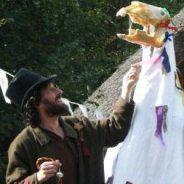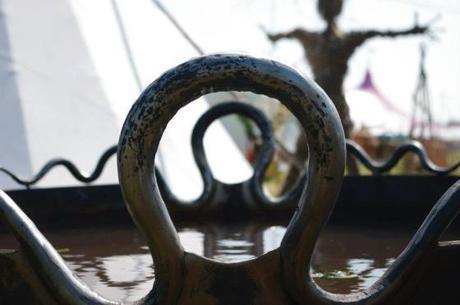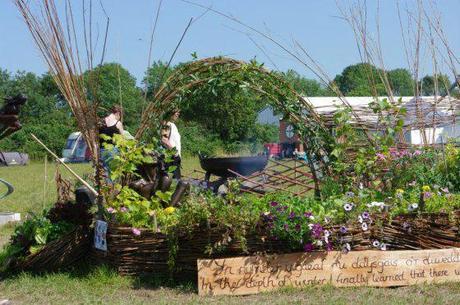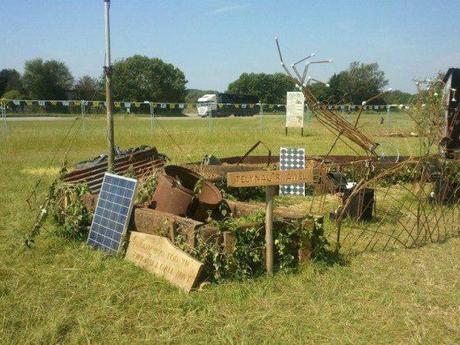

AmeriCymru member Nathan Lewis Williams is a freelance musician, sound engineer and music promoter working mostly in Glastonbury, England. He is a fluent Welsh speaker and was raised in Coedpoeth in North East Wales. He sings Welsh traditional music and translates Welsh poetry into English. This year he organised the first ever Green Field ( Maes Gwyrdd ) at the National Eisteddfod held on the Vale of Glamorgan between August 4th and 11th. AmeriCymru spoke to him about the event.

AmeriCymru: Croeso i AmeriCymru Nathan and many thanks for agreeing to this interview. Can you introduce the Maes Gwyrdd for our readers? What is its mission statement?
Nathan: Thanks for the welcome. It's great to be able to connect with our American family across the water! To answer your question:
One version of our mission statement is from the front page of our programme this year:
“Maes Gwyrdd: past, present and possible futures. A place where ancient culture and traditional skills may inform new perspectives and technologies. A place on the boundary of our familiar world and emerging realities. Somewhere that invites us to contemplate and consider what hopes and questions, qualities and visions we may have for a viable future together on this, our priceless Earth.”
Also, our full consitutional aims and objectives, and plenty of other details, including the programme of our activities this year on the main "e-Coleg" stage, are available on our website (which now needs updating somewhat - bear with us! - www.maesg.org.uk
AmeriCymru: What for you, will be/were the highlights of this years Maes Gwyrdd?
Nathan: Every talk at the e-Coleg was a revelation; we had some dedicated speakers of real insight and passion and it's very difficult to choose highlights from what was an amazingly varied and quite erudite programme of lectures: see our website for the full line-up. I loved the talk on Iolo Morganwg, pioneer of the Eisteddfod's Bardic Order, the Gorsedd, by Emeritus Professor Geraint H Jenkins - Iolo came across as a spirited radical and proto-ecologist who might have enjoyed the atmosphere of our Green Field had he been there to see it (some people even thought, in some spiritual sense, that he was!). Bob Evans' history of early Welsh harp music, with musical performances from his Crwth and vocals duo, Bragod, took things right back to fundamental, Pythagorean harmonic principles and was very accessible and well received. And on the political side, Jill Evans, European MP and Plaid Cymru advocate was both realistic and visionary in her call for a Green Revolution worldwide to counter the many economic and social problems we face today.
Musically, we had intimate and poetical performances from Gwyneth Glyn, Twm Morys and Gwilym Morus, all personal favourites of mine, and some new blood performing for almost the first time, including new band "Plu" who may make quite a stir if they keep going as they are, and Caradog and Aneurin on harp and guitar (the former also a younger member of Cymru Radical who closed the event for us with a talk on their experience of the Occupy Movement). We also had an outdoor stage on an old (prototype, painted green) Ifor Williams trailer, with battery powered guitar amps (rechargeables of course) providing enough volume for an intimate audience. Gai Toms and Plu were highlights here.
Many traditional crafts including boat making, willow sculpture, wood turning and - very popular these days - yurt making. Many of our structures were yurts, which were new to much of our Eisteddfod-going audience, including our impressive 60 foot yurt which housed the main e-Coleg stage. Seeing people's reactions to that beautiful structure - including the Eisteddfod organisers themselves - was a real highlight in itself, as was the reaction to our beautiful sculptures: a cauldron, labyrinth, wind harp sculpture, Iolo Morganwg willow sculpture and more, created by Coed Hills Rural Artspace Community from the Vale of Glamorgan and their associated artists. Photos of all this can be seen at our facebook site, Maes Gwyrdd 2012 also accessible via the front page of our website.
AmeriCymru: We learn from your website that - "The intention at Maes Gwyrdd will be to power everything on our area of the Eisteddfod field using renewable energy," How will you achieve this goal?
Nathan: We did - almost - achieve this goal. We ran our office from the battery of an electric car (made in Wales) supplied by Dragon Cars; these can in priciple be charged from renewable sources, of course! We ran the sound system and most of our Powerpoint projection at the e-Coleg from solar panels and a bank of batteries, which worked very well. Unfortunately we found that a bright projector, which was needed - ironically to counter the sunlight which powered the panels - used slightly more "juice" than we had, so we had a back-up power feed from the Science (Gwyddoniaeth) building nearby - diesel unfortunately! We hope to solve this by next year by:
1) Blacking out our slideshow area more effectively, enabling us to
2) Use a less powerful projector and
3) Programming fewer talks. There were a lot!
Next year we intend to focus more on music, and a little less on lectures; sound requires less power than a slide projector, especially as we tend to focus on folk music and acoustic instruments - not too much volume or bass - thus a P.A. amp using less than 30W can easily fill a performance space, and not drain batteries too much.
We also used solar panels to charge the batteries that powered the amps for the wind harp sculptures, and battery powered amps for musicians on the Garden Stage (Llwyfan yr Ardd). It never ceases to amaze me that you can put three musicians, i.e. two mics and a guitar input into one small battery powered amp (if you have the right splitters and adaptors) and it's plenty loud enough - as long as people are listening. Part of our "small is beautiful" aesthetic goes hand in hand with the emphasis on folk music: small, intimate audiences who are listening do not require big P.A.'s to blast across loud talking and drinking (which is what happens on the Eisteddfod's music stages elsewhere on site).
This is not to say that you can't get lots of volume from solar power - I've seen it done well by the Triban and Small World solar stages in the U.K. for example - though it's in fairly short bursts usually, and requires using speakers with low resistance and watching power consumption quite carefully. We'll aim to move more in this direction next year so that we can put louder bands (drum kits etc) on if necessary. Watching one's power consumption is an interesting way of looking at how we use technology - quite essential when using solar rigs for stages - and I am increasingly enjoying learning which of my various amps use lots of wattage and which don't, by using a measuring device easily purchased; often when we rely on the National Grid or easy diesel generation we take for granted having as much power as we need, and more if you count wasted power through leaving things switched on... Having to limit one's consumption actually makes one more aware, which can then filter into an awareness of how much we unnecessarily lose, or waste, in our everyday 240V lives.
AmeriCymru: Care to tell us a little more about the ecological workshops and crafts activities that were/will be available on the Maes Gwyrdd this year?
Nathan: As well as the crafts already mentioned, we had an acoustic music studio (again, no drum kits, but cajon, hand drums and acoustic instruments!) built using straw bales and turf - Stiwdio Gwellt Hafod, whose website (stiwdiogwellt.com) now has tens of recordings made during the 8 days of the Eisteddfod by some of Wales' best rock and folk performers, including young bands and older figures such as Tecwyn Ifan. Permaculture Wales brought a huge turf recreation of a mountainside in Pumlumon, as it would be if farmed using traditional sustainable methods. The Currach project (www.lynneallbutt.com/2012/06/discovering-new-territories-in-a-currach.html) displayed their hand crafted boat, similar to a coracle, which they intend to sail dawn the river Wye to the sea next year. Cwatrochos (www.carolisides.com) took some very strangely coloured photos in their photo booth (again, see our facebook site) of the public holding up cards displaying "What I Would Like To See"... A solar powered cinema graced us for a day, complete with ushers in fancy dress, and blew one blogger's mind (see http://www.swoosh.me.uk/en/news/swoosh-yr-ei-2012-dydd-3/09354.html) Kids' rides included a hand-turned carousel, climbing frame, trampolines and swingboats - all good old-fashioned human powered stuff.
In terms of workshops (all through the medium of Cymraeg, of course) we had Chi Gung meditation and Capoeira ( a form of dance / martial art from Brazil), willow fishing lines and fish for kids, basket making, pole lathe wood turning, knitting, story sharing, pottery, yurt making, a bicycle powered sewing machine repairing and making clothes (Carys Hedd's "stitch doctors") - another, similar bike-powered bit of interactive fun where kids and passers by pedalled to power a turntable playing Welsh and Breton music... also our labyrinth was pretty interactive: in the center was simply a tree, and, if you could find it, the text of a sonnet by R Williams Parry called "Propaganda'r Prydydd" (The Poet's Propaganda) in two languages which is about as magical a poem as one can find in the modern Welsh tongue. Saul, a Welsh stonemason, carved a eulogistic poeteical excerpt praising the Vale of Glamorgan by Iolo Morganwg (himself a stonemason by trade) on an oval stone sculpture set into the ground, which we hope will become a permanent memorial to Iolo in his local town of Cowbridge:
'Y Bardd yn Dychwelyd i Forgannwg wedi bod Flynyddau lawer yn Lloegr' gan Iolo Morganwg - dyfyniad
Cyfrifir hi beunydd yn frasaf o'r gwledydd,Dewiswyd gan Geraint H. Jenkins
Yn llannerch llawenydd, a'i gwenydd yn gain,
Gardd Cymru'n dra chymwys y'i gelwir, fro gulwys,
Gwlad irlwys, paradwys tir Prydain.
'The Bard Returning to Glamorgan having been many Years in England' by Iolo Morganwg - excerpt
She's constantly counted the grandest of lands,Chosen by Geraint H. Jenkins
As a glade of great joy, bright and fair in her mirth
The garden of Wales, aptly called, Vale of sanctity;
Green country, paradise of Britain's earth
AmeriCymru: Can you tell us a little about the e-Coleg? How do you see it evolving in future years?
Nathan: "ecoleg" is the Welsh word for ecology, and by inserting a hyphen, one arrives at a pun: an "e-College" - the "e" being our use of computerised slideshows etc, of course. The word "college" has bardic resonances, if one considers that the town nearest the Eisteddfod this year, Llantwit Major, once housed a Druidic College, many years before any Universities existed, a fact that would not have escaped that great reviver of modern Druidry, Iolo Morganwg himself. In the spirit of Iolo's pervading influence on our field, his prowess as a polymath, antiquarian and mystic as well as a practical craftsman and bard, we covered many subjects there, from the esoteric to the practical and political, taking an holistic approach whilst maintaining the highest possible standards of presentation and content.
Perhaps the most out-of-place speakers there were the politicians in their suits, who nonetheless gamely entered into the spirit of things, realising I'm sure that they were at an Eisteddfod in August holidays, with all the cultural overtones that has, and not a parliament or political rally! Nonetheless some very serious issues were covered, from fracking, wind power turbines and nuclear waste to supermarket food pricing and energy conservation; we used an historical context (including some very interesting academic lectures on medieval poetry for example) as a springboard to take us into thoughts about the ecology of the present, and a sustainable future for Wales. I hope that this formula for the e-Coleg forum - its informality combined with rigorous thought and debate - will develop and continue as the hub of our Green Field in the coming years.
AmeriCymru: Can you tell us more about the original artworks created for this year's event?
Nathan: The artworks were generally themed on ancient archetypes, in the spirit of Iolo's antiqurianism, and have been mentioned earlier. To list them again in more detail: a large metalworked cauldron over a fire (consisting of three large, slow burning elm logs) steaming away with a few herbs in it, and a single stone immersed (stone soup, anyone?!) - see a photo of it here:-

Amazing permaculture gardens, with quotes written on boards to get one thinking, designed by Michelle Fitzsimmons of ediblelandscapes.co.uk, again photos are on facebook

The wind harps were made of iron, in the shapes of hands, and each finger held a taut string, ten in all, tuned to the harmonic series on a C# with A at 432 Hz. Any musos may understand the implications of this tuning, for those who don't: C# at concert pitch 432Hz is the note traditionally used as a drone in Indian classical music, possibly because it is an octave of the solar year, 365.25 days - thus bringing Earth and Sun together in a musical union - or something. See it as you will. The interpretations, and reactions to the harps ranged from hostility and bemusement to enthusiasm and intrigue. My first feeling on seeing them (I was involved in commissioning them) was to be shocked at their ugliness, but then realised that they had a strange beauty of their own, and that they made a fascinating comment on (post-?)industrialism. Interestingly they were placed on the edge of Llandow Trading estate, and very near the site of an ancient burial mound (on Tumulus Way!). And they made a very beautiful sound. The gardens built around them by Michelle and co reflected the dystopian reality that their iron ugliness implied: old railway sleepers, corrugated iron and discarded bike wheels formed what Jill Bach, one of our founders, called a kind of "Mad Max" reality around them. As a piece of modern art, in shock value and cultural resonance they had a worthiness all of their own, though not everyone appreciated them. One radio interviewer was so rude about them during a live interview - and was plucking them as loudly and harshly as he could to make them sound as bad as possible (wind harps, my friend, wind harps, you fool!) that I found myself snatching the microphone from his hand and leaving him, for a while, with dead air (ah, the sweet sound of Cage's 4'33") until he calmed down...See facebook for photos of these harps and the "Mad Max" gardens:-

or check out the filmed interview with Jill Bach where she demonstrates the harps by gently plucking them.
Sianel62 - Jill Bach yn y Steddfod from Sianel62 | Cymdeithas on Vimeo.
The other garden, at Llwyfan yr Ardd, the aforementioned Garden Stage, was by contrast utopian and extraordinarily beautiful, and took many hours to create. The media, for some reason, were less interested in this one!
Little wind harp scultures by Bob Rowberry twinkled ar whirred in the breeze, and bronze figures of great naturalism and beauty all graced the field, particularly around the labyrinth, which, encircled also by trees, was probably the nearest thing the Eisteddfod has seen to a Druidic Grove for some time... Coed Hills did a magnificent job of pulling so many talented artists together, and our job was then to place things appropriately (Feng Shui!) so that the Green Field as a whole made coherent, and harmonious, sense.
AmeriCymru: What plans do you have for next year in Denbighshire?
Nathan: We'll have to scale it back a bit! We may not have the luxury of an Arts Council Grant for the visual side of things, and we've certainly got less space to play with. I'd like to see the e-Coleg continue, and programme more music so that we get more of a buzz going for the public, and draw people in even more. The kids' rides and acivities were very successful this year, and I'd like to see that continue. Also I'd like to develop our cafe, and source more local and organic food and offer more vegan options than we did this year. There are limitations imposed by the Eisteddfod as to what we can do food-wise but we'd like to develop that side if at all possible. Without as much support from Coed Hills, and their director Rawley in particular, we'll be building a new team to run things; and Maes Gwyrdd will inevitably have to re-invent itself from year to year as it travels from South to North, and back again. The idea is that a local cultural network centre, or centres, can form the hub for organising Maes Gwyrdd as the Eisteddfod moves around Wales, and form links with Wales' national festival which can be mutually beneficial. It certainly worked with Coed Hills this year; we are seeking such a center in the North at present, and have a few ideas, but nothing definite yet.
Personally, I'm trying right now to balance being on holiday, for the first time in a long while, with keeping up the momentum of what we've just achieved, publicising what was certainly a great success for us, and updating the website and facebook pages. The latter is a little easier to deal with, so if anyone is interested ineither seeing photos, links to other articles on line, or getting involved, please do visit Maes Gwyrdd 2012 here
AmeriCymru: Any final message for the members and readers of AmeriCymru?
Nathan: Well, it's great to hear what you guys are up to with the West Coast Eisteddfod, and if there are any links that can be made between that organisation and ours, then bring it on. I sometimes feel that those brothers and sisters on the other side of "the pond" may have something to teach us, or inform us, about fresh perspectives for Wales' own Eisteddfod. Jen Delyth has been great in allowing us to use her "Tree Of Life" design in our publicity, and I wouldn't be surprised if the Green Field, Maes Gwyrdd, makes many new friends in America, both for itself and for the National Eisteddfod itself as a whole. Diolch yn fawr, Ceri, am bob cefnogaeth hyd yn hyn. Thanks, Ceri and AmeriCymru for your support so far. I've already made contact with people here in Wales through this website so things come full circle here too!
Hwyl am y tro, a phob bendith.
Nathan Lewis Williams
Interview by Ceri Shaw



